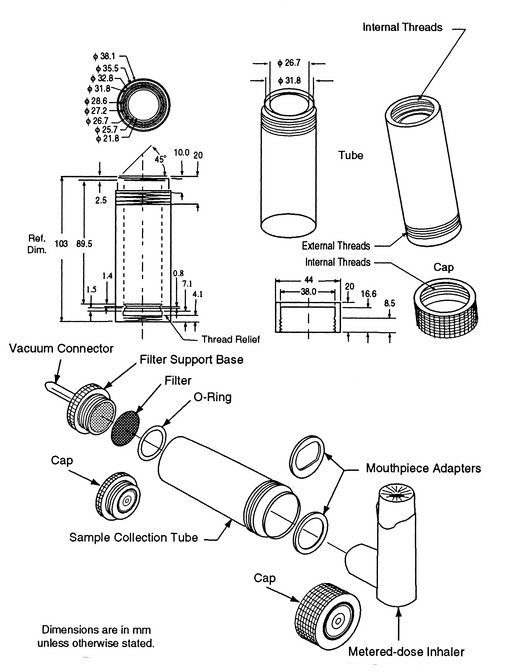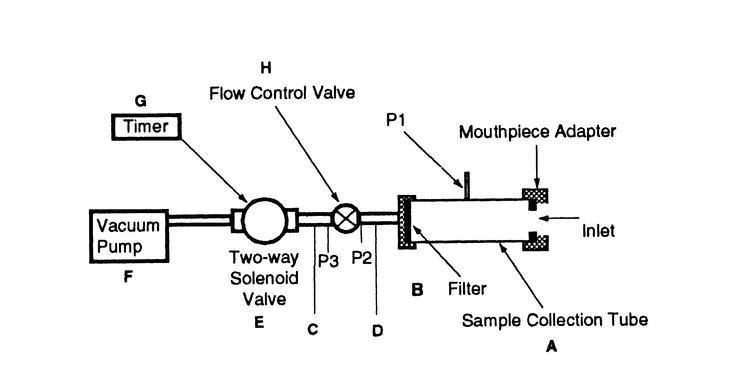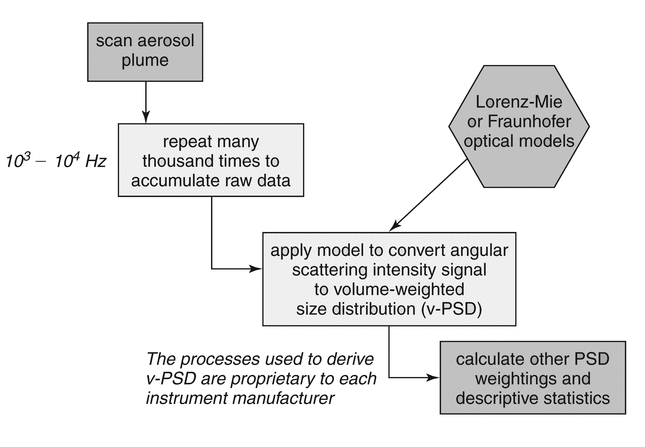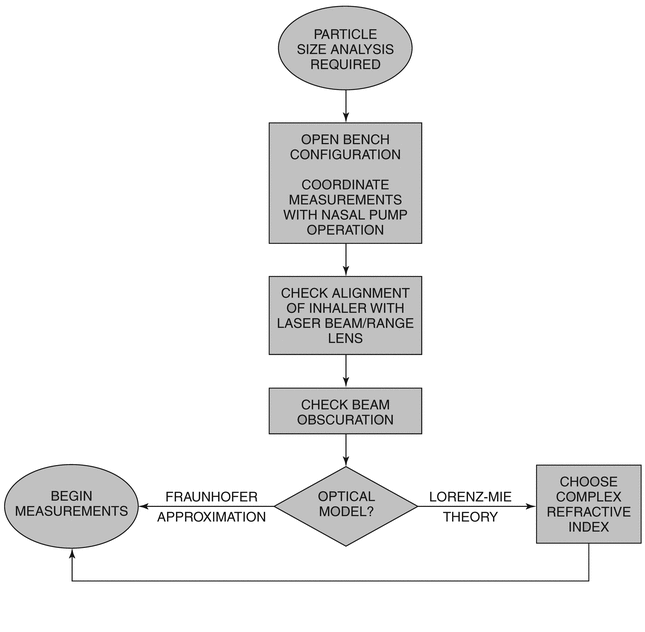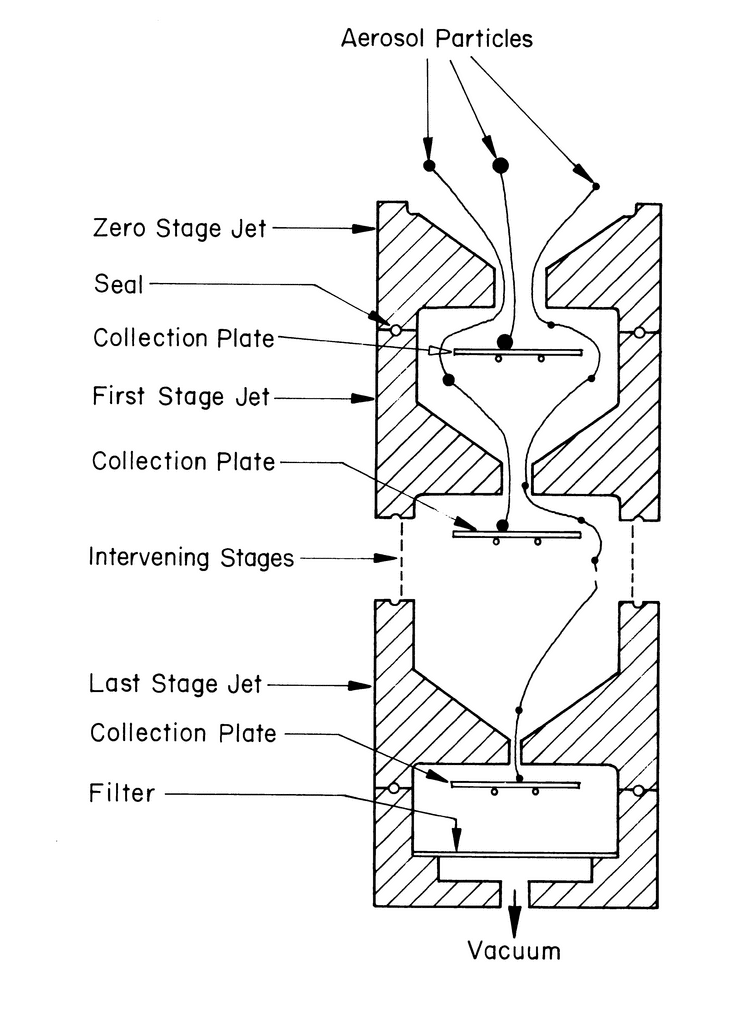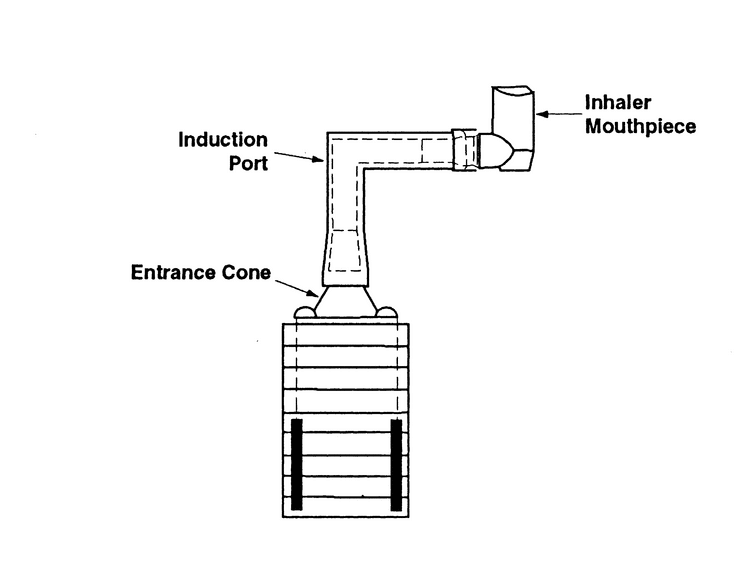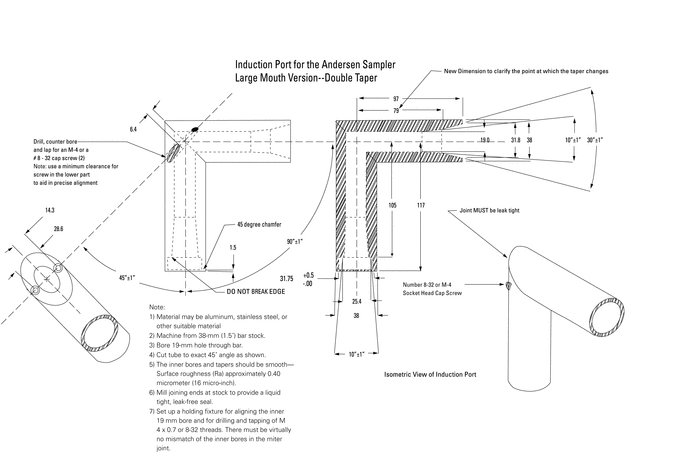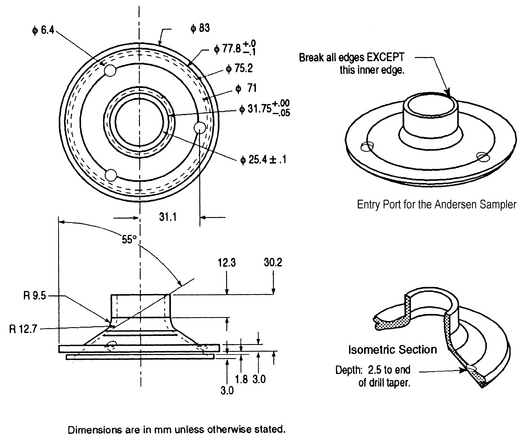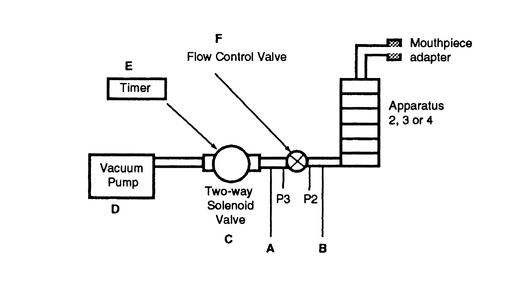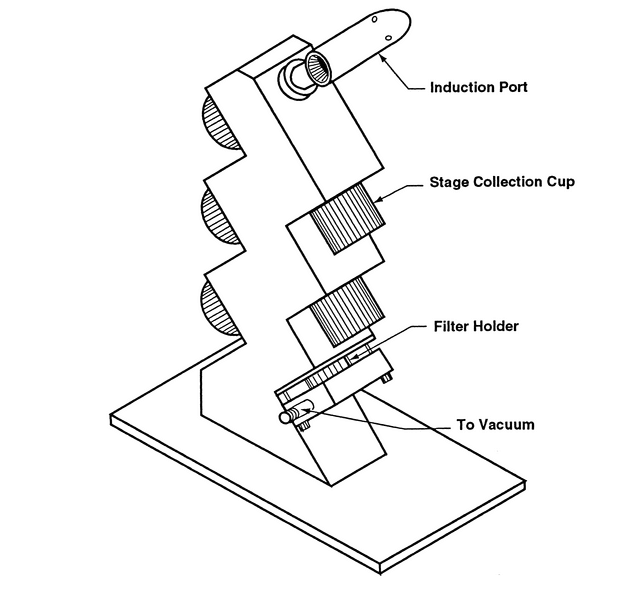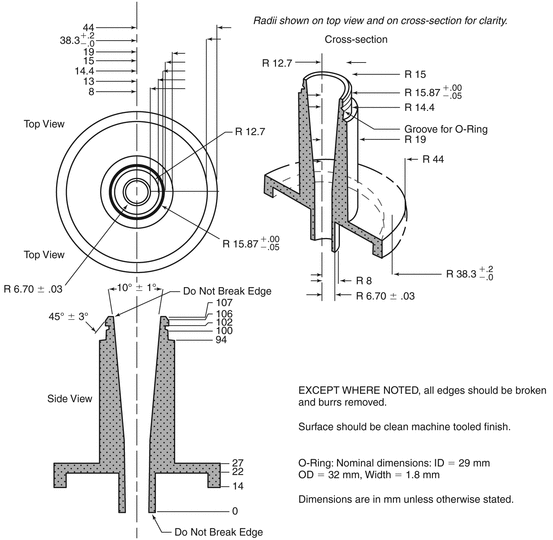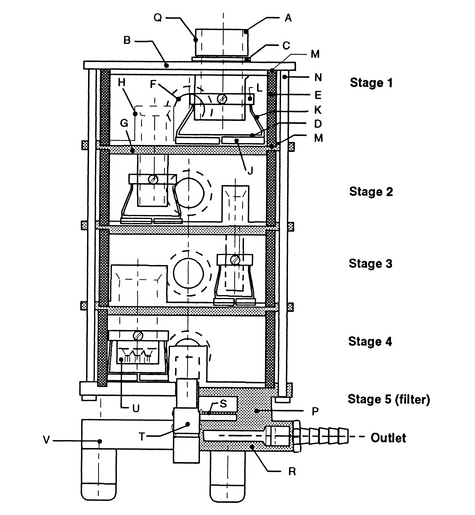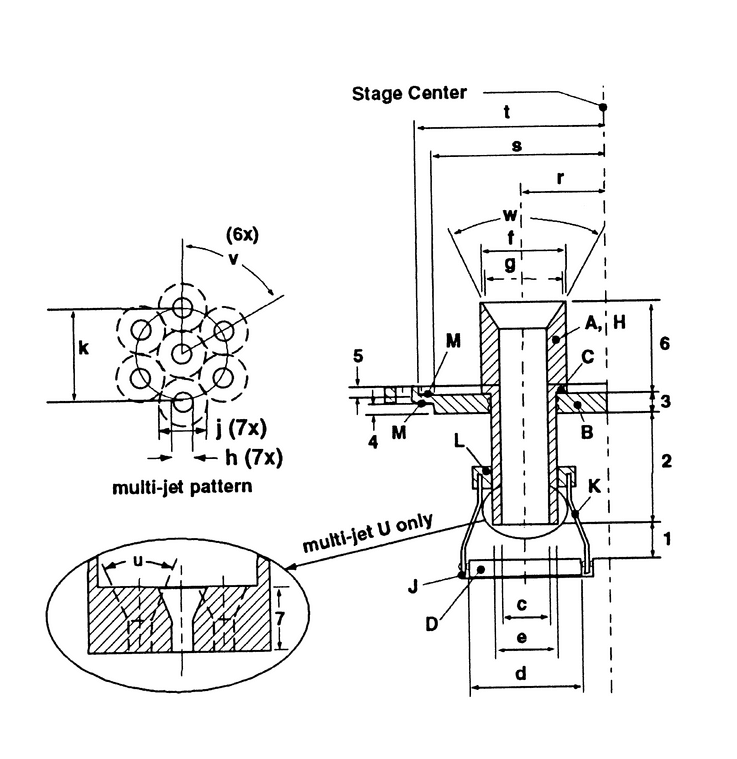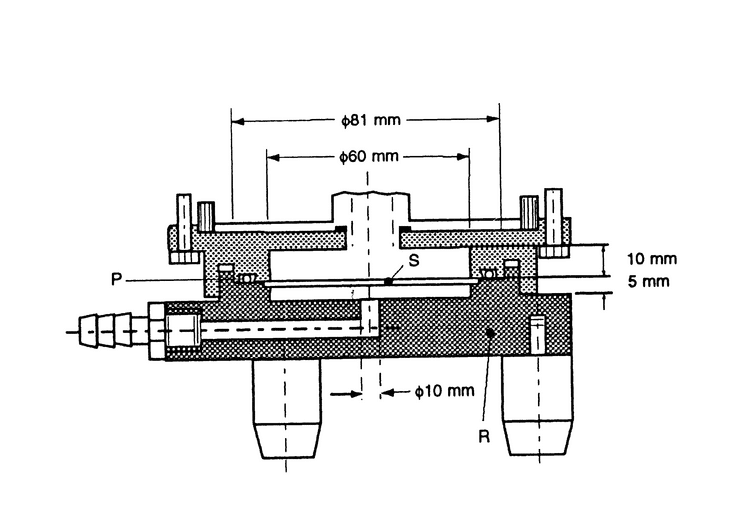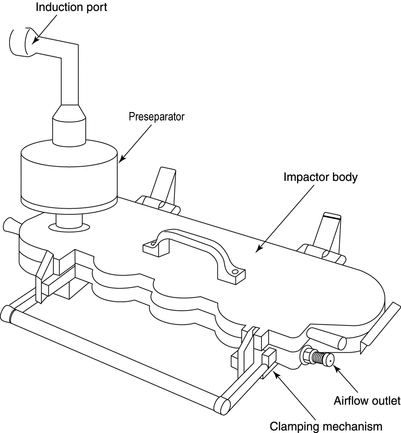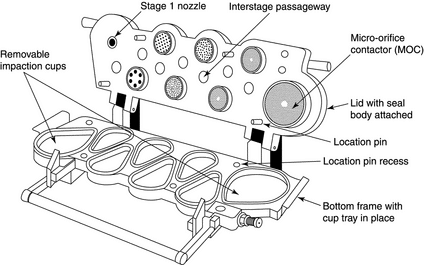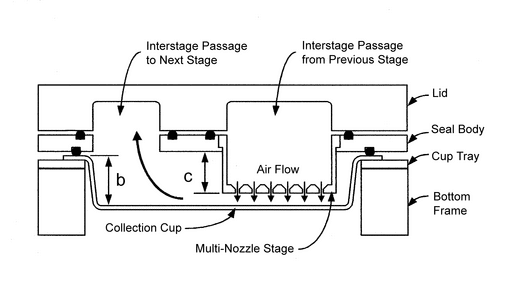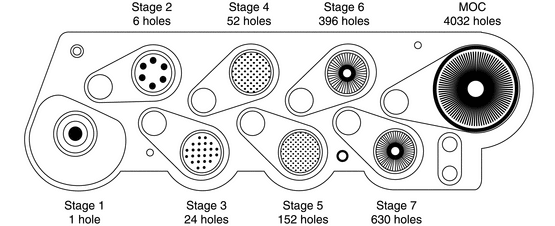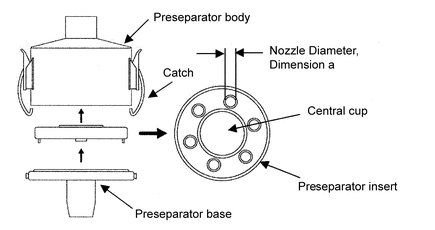TABLE OF CONTENTS
| Introduction
|
|
| A. Delivered-Dose Uniformity | |
| A.1 Nasal Aerosols and Nasal Sprays | |
| A.1.1 Delivered-Dose Uniformity of Product | |
| A.1.1.1 Sampling the Delivered Dose from Nasal Sprays | |
| A.1.1.2 Sampling the Delivered Dose from Nasal Aerosols | |
| A.2 Inhalation Aerosols and Inhalation Sprays | |
| A.2.1 Delivered-Dose Uniformity of Product | |
| A.2.1.1 Sampling the Delivered Dose from Inhalation Aerosols and Inhalation Sprays | |
| A.3 Nasal Powders | |
| A.3.1 Delivered-Dose Uniformity of Product | |
| A.3.1.1 Sampling the Delivered Dose from Nasal Powders | |
| A.4 Inhalation Powders | |
| A.4.1 Delivered-Dose Uniformity of Product | |
| A.4.1.1 Sampling the Delivered Dose from Inhalation Powders | |
| B. Droplet/Particle Size Distribution—Nasal Aerosols, Sprays, and Powders | |
| B.1 Particle Size Measurement by Laser Diffraction | |
| C. Aerodynamic Size Distribution—Inhalation Aerosols, Sprays, and Powders | |
| C.1 General Principles of Aerodynamic Particle Size Measurement | |
| C.1.1 Stage Mensuration | |
| C.1.2 Interstage Drug Loss (Wall Losses) | |
| C.1.3 Re-Entrainment | |
| C.1.4 Mass Balance | |
| C.2 Apparatus 1 for Inhalation Aerosols and Sprays—Andersen Impactor (without Pre-separator) | |
| C.2.1 Design—Apparatus 1 | |
| C.2.2 Procedure—Apparatus 1 | |
| C.3 Apparatus 2 for Inhalation Powders—Marple-Miller Impactor | |
| C.3.1 Design—Apparatus 2 | |
| C.3.2 Procedure—Apparatus 2 | |
| C.4 Apparatus 3 for Inhalation Powders—Andersen Impactor (with pre-separator) | |
| C.4.1 Design—Apparatus 3 | |
| C.4.2 Procedure—Apparatus 3 | |
| C.5 Apparatus 4 for Inhalation Powders—Multistage Liquid Impinger | |
| C.5.1 Design—Apparatus 4 | |
| C.5.2 Procedure—Apparatus 4 | |
| C.6 Apparatus 5 for Inhalation Powders—Next Generation Impactor (with pre-separator) | |
| C.6.1 Design—Apparatus 5 | |
| C.6.2 Procedure—Apparatus 5 | |
| C.7 Apparatus 6 for Inhalation Aerosol and Sprays—Next Generation Impactor (with pre-separator) | |
| C.7.1 Design—Apparatus 6 | |
| C.7.2 Procedure—Apparatus 6 | |
INTRODUCTION
The major performance measures for nasal and inhalation aerosols, sprays, and powders relate to dose delivery to the patient, including delivered-dose uniformity and relevant measures of particle size (optical or aerodynamic) depending on the dosage form. Each of these is described in the following sections. A nomenclature table appears in Inhalation and Nasal Drug Products—General Information and Product Quality Tests  5
5 , from which the descriptive terms for various dosage forms can be obtained.
, from which the descriptive terms for various dosage forms can be obtained.
A. DELIVERED-DOSE UNIFORMITY
A.1 Nasal Aerosols and Nasal Sprays
The following test is applicable to nasal aerosols and sprays formulated as nonaqueous or aqueous suspensions or solutions of drug, presented typically in multidose containers, and fitted with dose-metering valves or pumps. In all cases and for all tests, prepare and test the spray as directed in the labeling and the instructions for use.
a.1.1 delivered-dose uniformity of product
Unless otherwise directed in the individual monograph, the drug content of the minimum delivered doses collected at the beginning of unit life, and also at the end of unit life, will be determined from each of 10 separate containers. This represents a total of 20 determinations. These measurements shall be made after priming as described in the labeling or instructions for use. The number of doses not to exceed 2 sprays (i.e., a total of 20 determinations).
A.1.1.1 Sampling the delivered dose from nasal sprays
Procedure—
To ensure reproducible in vitro dose collection, it is recommended that a mechanical means of actuating the metering system or pump assembly be used to deliver doses for collection. The mechanical actuation procedure should have adequate controls for the critical mechanical actuation parameters (e.g., actuation force, actuation speed, stroke length, and rest periods). The test must be performed on units that have been thoroughly shaken and primed according to the patient-use instructions. The test unit should be actuated in a vertical or near-vertical, valve-up position. The dose collected at the beginning of each of the 10 test containers should be the dose immediately following priming, and the dose collected at the end of each container's life should correspond to the last label claim number of doses from the same container. The doses between the two sequential test samples should be disposed of appropriately.
For suspension products, the dose should be delivered into a suitable container (e.g., scintillation vial) in which quantitative transfer from the container under test can be accomplished. A validated analytical method is employed to determine the amount of drug in each delivered dose, and data are reported as a percent of label claim. For solution products, the delivered dose can be determined gravimetrically from the weight of the delivered dose and the concentration and density of the fill solution of the product under test.
A.1.1.2 Sampling the delivered dose from nasal aerosols:
See A.2.1.1 Sampling the Delivered Dose from Inhalation Aerosols and Inhalation Sprays.
A.2 Inhalation Aerosols and Inhalation Sprays
The following tests are applicable to inhalation aerosols (commonly known as metered-dose inhalers) and inhalation sprays. Inhalation aerosols are formulated as suspensions or solutions of a drug substance in propellants and possibly other suitable excipients and are presented as multidose units. Inhalation sprays typically are aqueous-based liquid formulations packaged in a compact container–closure system containing an integral spray pump unit. Refer to  5
5 for additional information. The following test methods are specific to these products and may require modification when analysts test alternative inhalation technologies (for example, breath-actuated inhalation aerosols or inhalation sprays). However, pharmacopeial requirements for all dose-metered inhalation dosage forms require determination of the delivered dose and aerodynamic size distribution. In all cases and for all tests prepare and test the product as directed on the label and the instructions for use. When these directions are not provided by the product manufacturer, follow the precise dose-discharge directions included in the following tests.
for additional information. The following test methods are specific to these products and may require modification when analysts test alternative inhalation technologies (for example, breath-actuated inhalation aerosols or inhalation sprays). However, pharmacopeial requirements for all dose-metered inhalation dosage forms require determination of the delivered dose and aerodynamic size distribution. In all cases and for all tests prepare and test the product as directed on the label and the instructions for use. When these directions are not provided by the product manufacturer, follow the precise dose-discharge directions included in the following tests.
a.2.1 delivered-dose uniformity of product
The test for Delivered-Dose Uniformity is required for inhalation aerosols and inhalation sprays containing drug formulation (e.g., solution or suspension) either in device-metered or in pre-metered unit presentations. The test for Delivered-Dose Uniformity includes dose uniformity over the entire unit life. (For products packaged in pre-metered dosage units, see also Uniformity of Dosage Units  905
905 .) A dose in this test is defined as the minimum recommended number of sprays specified in the product labeling or instructions for use but not more than two sprays. For inhalation aerosols and inhalation sprays, the target-delivered dose is specified by the label claim, unless otherwise specified in the individual monograph. Its value reflects the expected mean drug content for a large number of delivered doses collected from many units of the product using the method specified in the monograph.
.) A dose in this test is defined as the minimum recommended number of sprays specified in the product labeling or instructions for use but not more than two sprays. For inhalation aerosols and inhalation sprays, the target-delivered dose is specified by the label claim, unless otherwise specified in the individual monograph. Its value reflects the expected mean drug content for a large number of delivered doses collected from many units of the product using the method specified in the monograph.
Unless otherwise directed in the individual monograph, the drug content of the delivered doses collected at the beginning of unit life (after priming as described on the label or instructions for use) and end of unit life of the label claim, will be determined from each of 10 separate containers (i.e., a total of 20 determinations).
A.2.1.1 Sampling the delivered dose from inhalation aerosols and inhalation sprays
Procedure—
To determine the content of active ingredient in the discharged plume from an inhalation aerosol and inhalation spray, use the sampling Apparatus A (see Figure 1) described below. Prepare the product for use according to the label instructions for shaking, priming, and firing. Unless otherwise specified in the individual monograph, with the vacuum pump running, ensuring an airflow rate through the product device of 28.3 L of air per minute (±5%), discharge the minimum recommended actuations into the apparatus through the mouthpiece adapter by actuating the metering system for a duration sufficient to ensure that the dose has been completely discharged. The volume of air sampled should not exceed 2.0 L. The dose collected from each of the 10 test containers should be the dose immediately following priming, and the dose collected at the end of each container's life should be the last dose according to the label claim. Unless otherwise prescribed in the patient instructions, shake the product for 5 s, and collect the first actuation following priming. Wait for 5 s and collect the next actuation, if justified. The doses between the two sequential test samples (i.e., beginning and end of container life) should be disposed of appropriately. Note that for inhalation aerosols the rate of discharges (number of discharges per unit time) to waste should not cause excessive canister cooling. Following separate collections of the minimum number of actuations from each unit at each sequential test sample, detach the product from Apparatus A (see Figure 1), and disconnect the vacuum. Separately assay the contents of the apparatus for drug at the beginning and end sequential test samples after rinsing the filter and the interior of the apparatus with a suitable solvent.
Apparatus A—
The sampling apparatus (see Figure 1) consists of a filter support base with an open-mesh filter support such as a stainless steel screen, a collection tube that is clamped or screwed to the filter support base, and a mouthpiece adapter to ensure an airtight seal between the collection tube and the mouthpiece. Use a mouthpiece adapter that ensures that the opening of the product’s mouthpiece is flush with the front face or 2.5-mm indented shoulder in the sample collection tube, as appropriate. The vacuum connector is connected to a system comprising a vacuum source, flow regulator, and flowmeter. The source should be capable of pulling air through the complete assembly, including the filter and the product to be tested, at the desired flow rate. During tests of inhalation aerosols, air should be drawn continuously through the system to avoid loss of drug into the atmosphere. The filter support base is designed to accommodate 25-mm diameter filter disks. At the airflow used, the sample collection tube and the filter disk must be capable of quantitatively collecting the delivered dose. The filter disk and other materials used in the construction of the apparatus must be compatible with the drug and the solvents that are used to extract the drug from the filter. One end of the collection tube is designed to hold the filter disk tightly against the filter support base. When assembled, the joints between the components of the apparatus are airtight so that when a vacuum is applied to the base of the filter, all of the air drawn through the collection device passes through the product device.
A.3 Nasal Powders
The following test is applicable to nasal powders presented in pre-metered and device-metered units. In all cases and for all tests, prepare and test the powder as directed in the labeling and the instructions for use.
a.3.1 delivered-dose uniformity of product
Unless otherwise directed in the individual monograph, the drug content of the minimum delivered doses from each of 10 separate containers will be determined at the beginning of unit life and again at the label claim number of metered doses. This represents a total of 20 determinations. For nasal powders packaged in single-dose units, Delivered-Dose Uniformity can be applied on 10 dosage units.
A.3.1.1 Sampling the delivered dose from nasal powders:
To ensure reproducible in vitro dose collection, it is recommended that appropriate means of actuating the device assembly be used to deliver doses for collection. The test unit should be actuated in a vertical or near-vertical position. The two separate doses collected include the first dose and the dose corresponding to the last labeled dose from each of 10 units. The doses between the two sequential test samples for each unit should be disposed of appropriately. A validated analytical method is used to determine the amount of drug in each delivered dose, and data are reported as a percentage of label claim. Apparatus B (Figure 2) is recommended for nasal powders.
A.4 Inhalation Powders
The following tests are applicable to inhalation powders (commonly known as dry powder inhalers) presented as pre-metered or device-metered units. Pharmacopeial requirements for all these drug products require determination of the delivered dose and aerodynamic size distribution. In all cases and for all tests, prepare and test the product as directed in the labeling and the instructions for use. When these directions are not provided by the product manufacturer, follow the precise dose-discharge directions included in the following tests.
a.4.1 delivered-dose uniformity of product
The test for Delivered-Dose Uniformity is required for inhalation powders in device-metered and in pre-metered (including ordered multiple-dose) presentations as labeled for use with the specified delivery system. The test for Delivered-Dose Uniformity includes dose uniformity over the entire unit life. (For formulations packaged in pre-metered dosage units, see also  905
905 .) Note that the target delivered dose is the expected mean drug content for a large number of delivered doses collected from many units under defined experimental conditions. In many cases, the target value may depend on the manner in which the test for delivered dose is performed. For inhalation powders, where the label claim usually is the pre-metered or metered dose of drug, the target delivered dose is specified in the individual monograph and usually is less than the label claim. Its value reflects the expected mean drug content for a large number of delivered doses collected from the product using the method specified in the monograph.
.) Note that the target delivered dose is the expected mean drug content for a large number of delivered doses collected from many units under defined experimental conditions. In many cases, the target value may depend on the manner in which the test for delivered dose is performed. For inhalation powders, where the label claim usually is the pre-metered or metered dose of drug, the target delivered dose is specified in the individual monograph and usually is less than the label claim. Its value reflects the expected mean drug content for a large number of delivered doses collected from the product using the method specified in the monograph.
Unless otherwise directed in the individual monograph, the drug content of the minimum delivered dose from each of 10 separate units is determined in accordance with the procedure described as follows.
The test for Delivered-Dose Uniformity over the entire unit life is required for drug products packaged in device-metered or in ordered multiple-dose metering units of pre-metered dosage units that have a predetermined dose sequence.
Unless otherwise directed in the individual monograph, the drug content of the delivered doses will be collected at the beginning of unit life and again at the label claim number of doses. Two determinations will be obtained from each of 10 separate drug product units. This represents a total of 20 determinations.
For inhalation powders packaged in single dosage form units, Delivered-Dose Uniformity can be applied on 10 dosage units.
A.4.1.1 Sampling the delivered dose from inhalation powders:
To determine the content of active ingredient emitted from the mouthpiece of an inhalation powder, use Apparatus B (see Figure 2). This apparatus is capable of sampling the emitted doses at a variety of airflow rates.
Figure 2. Apparatus B: Sampling apparatus for inhalation powders. (See Table 1 for component specifications.)
Table 1. Component Specifications for Apparatus B (see Figure 2)
| Code | Item | Description | Dimensions |
|---|---|---|---|
| A | Sample collection tubea | See Figure 2 | 34.85-mm ID × 12-cm length |
| B | Filterb | See Figure 2 | 47-mm glass fiber filter |
| C | Connector | (e.g., short metal coupling with low-diameter branch to P3) | |
| D | Vacuum tubing | (e.g., silicon tubing with an outside diameter of 14 mm and an internal diameter of 8 mm) | A length of suitable tubing |
| E | Two-way solenoid valvec | See Figure 2 | 2-way, 2-port solenoid valve having an ID |
| F | Vacuum pumpd | See Figure 2 | Pump must be capable of drawing the required flow rate through the assembled apparatus with the inhalation powder in the mouthpiece adapter. Connect the pump to the solenoid valve using short and wide ( |
| G | Timere | See Figure 2 | The timer switches current directly to the solenoid valve for the required duration. |
| P1 | Pressure tap | See Figure 2 | 2.2-mm ID, 3.1-mm OD flush with the internal surface of the sample collection tube, centered and burr free, 59 mm from its inlet. The pressure taps P1, P2, and P3 must not be open to the atmosphere during dose collection. |
| P1, P2, P3 | Pressure measurementsf | — | — |
| H | Flow-control valveg | See Figure 2 | Adjustable regulating valve with maximum Cv |
|
a
An example is a Millipore product number XX40 047 00 (Millipore Corporation, 80 Ashby Road, Bedford, MA 01732) modified so that the exit tube has an ID
b
A/E (Gelman Sciences Inc., 600 South Wagner Road, Ann Arbor, MI 48106) or equivalent.
c
ASCO product number 8030G13, Automatic Switch Company, 60 Hanover Road, Florham Park, NJ 07932.
d
Gast product type 1023, 1423, or 2565 (Gast Manufacturing Inc., PO Box 97, Benton Harbor, MI 49022) or equivalent.
e
Eaton Product number 45610-400 (Eaton Corporation, Automotive Products Division, 901 South 12th Street, Watertown, WI 53094) or equivalent.
f
An example is a PDM 210 pressure meter (Air-Neotronics Ltd., Neotronics Technology plc, Parsonage Road, Takeley, Bishop's Stortford, CM22 6PU, UK) or equivalent.
g
Parker Hannifin type 8FV12LNSS (Parker Hannifin plc., Riverside Road, Barnstable, Devon EX31 1NP, UK) or equivalent.
h
Flow Coefficient, as defined by ISA S75.02 Control valve capacity test procedure in Standards and Recommended Practices for Instrumentation and Control, 10th ed., Vol. 2, 1989. Published by Instrument Society of America, 67 Alexander Drive, PO Box 1227, Research Triangle Park, NC 27709, USA.
|
|||
Apparatus B—
The apparatus is similar to that described in Figure 1 for testing inhalation aerosols. In this case, however, the filter and collection tube have a larger internal diameter to accommodate 47-mm diameter filter disks. This feature enables dosage collection at higher airflow rates—up to 100 L of air/min—when necessary. A mouthpiece adapter ensures an airtight seal between the collection tube and the mouthpiece of the inhalation powder being tested. The mouthpiece adapter must ensure that the tip of the product's mouthpiece is flush with the open end of the sample collection tube. Tubing connectors, if they are used, should have an internal diameter  8 mm to preclude their own internal diameters from creating significant airflow resistance. A vacuum pump with excess capacity must be selected in order to draw air at the designated volumetric flow rate through both the sampling apparatus and the product simultaneously. A timer-controlled, low-resistance, solenoid-operated, two-way valve is interposed between the vacuum pump and the flow-control valve to control the duration of flow. This type of valve enables 4.0 L of air (±5%) to be withdrawn from the mouthpiece of the product at the designated flow rate. Flow control is achieved by ensuring that critical (sonic) flow occurs in the flow-control valve (absolute pressure ratio P3/P2 is
8 mm to preclude their own internal diameters from creating significant airflow resistance. A vacuum pump with excess capacity must be selected in order to draw air at the designated volumetric flow rate through both the sampling apparatus and the product simultaneously. A timer-controlled, low-resistance, solenoid-operated, two-way valve is interposed between the vacuum pump and the flow-control valve to control the duration of flow. This type of valve enables 4.0 L of air (±5%) to be withdrawn from the mouthpiece of the product at the designated flow rate. Flow control is achieved by ensuring that critical (sonic) flow occurs in the flow-control valve (absolute pressure ratio P3/P2 is  0.5 under conditions of steady-state flow).
0.5 under conditions of steady-state flow).
Procedure—
Operate the apparatus at an airflow rate that produces a pressure drop of 4 kPa (40.8 cm H2O) over the product to be tested and for a period consistent with the withdrawal of 2.0 L of air from the mouthpiece of the product. [Note—If the flow rate and duration are defined otherwise in the monograph, adjust the system to within 5% of those values. ] The volume of air sampled should not exceed 2.0 L. Determine the test flow rate using Apparatus B as follows. Insert the product into the mouthpiece adapter to ensure an airtight seal. In cases where the drug packaging modifies the product’s resistance to airflow, use a loaded, drug-free device (with previously emptied packaging). In other cases, use an unloaded (drug-free) device. Connect one port of a differential pressure transducer to the pressure tap, P1, and leave the other open to the atmosphere. Switch on the pump, and open the two-way solenoid valve. Adjust the flow-control valve until the pressure drop across the product is 4.0 kPa (40.8 cm H2O). Ensure that critical (sonic) flow occurs in the flow-control valve by determining the individual values for absolute pressure, P2 and P3, so that their ratio P3/P2 is  0.5. If this ratio of P3/P2 is not achieved, switch to a more powerful pump and remeasure the test flow rate. Critical (sonic) flow conditions in the flow-control valve are required in order to ensure that the volumetric airflow drawn from the mouthpiece is unaffected by pump fluctuations and changes in airflow resistance of the product. Remove the product from the mouthpiece adapter and, without disturbing the flow-control valve, measure the airflow rate drawn from the mouthpiece, Qout, by connecting a flowmeter to the mouthpiece adaptor in an airtight fashion. Use a flowmeter calibrated for the volumetric flow leaving the meter in an airtight fashion to directly determine Qout or, if such a meter is unobtainable, calculate the volumetric flow leaving the meter (Qout) using the ideal gas law. For example, for a meter calibrated for the entering volumetric flow (Qin) calculate:
0.5. If this ratio of P3/P2 is not achieved, switch to a more powerful pump and remeasure the test flow rate. Critical (sonic) flow conditions in the flow-control valve are required in order to ensure that the volumetric airflow drawn from the mouthpiece is unaffected by pump fluctuations and changes in airflow resistance of the product. Remove the product from the mouthpiece adapter and, without disturbing the flow-control valve, measure the airflow rate drawn from the mouthpiece, Qout, by connecting a flowmeter to the mouthpiece adaptor in an airtight fashion. Use a flowmeter calibrated for the volumetric flow leaving the meter in an airtight fashion to directly determine Qout or, if such a meter is unobtainable, calculate the volumetric flow leaving the meter (Qout) using the ideal gas law. For example, for a meter calibrated for the entering volumetric flow (Qin) calculate:
P0 = atmospheric pressure
DP = pressure drop over the meter
If the flow rate is >100 L of air/min, adjust the flow-control valve until Qout equals 100 L/min; otherwise, record the value of Qout, and leave the flow-control valve undisturbed. Define the test flow duration, e.g., at 60 L/min T = 120/Qout, in seconds, so that a volume of 2.0 L of air (±5%) is withdrawn from the product at the test flow rate Qout, and adjust the timer controlling the operation of the two-way solenoid valve accordingly. Prime or load the device with powder for inhalation according to the labeled instructions. With the vacuum pump running and the solenoid valve closed, insert the product's mouthpiece horizontally into the mouthpiece adapter. Discharge the powder into the sampling apparatus by activating the timer controlling the solenoid valve and withdrawing 2.0 L of air from the product at the previously defined airflow rate. Repeat the whole operation n  1 times beginning with the text, “Prime or load the device with powder,” where n is the number of times defined in the labeling as the minimum recommended dose. Detach the inhalation powder device container from the sampling apparatus, and disconnect the vacuum tubing, D. Assay the contents of the apparatus for drug after rinsing the filter and the interior of the apparatus with a suitable solvent. Where specified in the individual monograph, perform this test under conditions of controlled temperature and humidity.
1 times beginning with the text, “Prime or load the device with powder,” where n is the number of times defined in the labeling as the minimum recommended dose. Detach the inhalation powder device container from the sampling apparatus, and disconnect the vacuum tubing, D. Assay the contents of the apparatus for drug after rinsing the filter and the interior of the apparatus with a suitable solvent. Where specified in the individual monograph, perform this test under conditions of controlled temperature and humidity.
Qout = QinP0/(P0  DP)
DP)
P0 = atmospheric pressure
DP = pressure drop over the meter
B. DROPLET/PARTICLE SIZE DISTRIBUTION—NASAL AEROSOLS, SPRAYS, AND POWDERS
For suspension and solution nasal aerosols, sprays, and powders, the emitted droplet/particle size distribution should be determined for the delivered plume subsequent to delivery under specified experimental conditions. If a laser diffraction method is used (for more detail, refer to the description of this method in the following section), droplet size distribution can be controlled in terms of ranges for the 10th (D10), 50th (D50), and 90th (D90) percentiles of the cumulative volume (mass)-weighted size distribution, as well as the span of the distribution, expressed as [(D90 – D10)/D50], and the percentage of droplets less than 10 µm. Note that D50 is identical with the volume (mass) median diameter if the distribution is unimodal. Appropriate and validated or calibrated emitted droplet/particle size analytical procedures should be described in sufficient detail to allow accurate and reproducible assessment including the following:
- complete information about the apparatus and accessories
- theoretical model (Lorenz–Mie or Fraunhofer approximation)
- the application of a disabling option for one or more of the innermost detectors to mitigate beam steering effects (only applicable to nasal aerosols)
- software version
- sample placement with respect to the optical bench of the laser diffractometer
- measurement range
- beam width
- laser trigger condition in connection with the initiation and termination of the measurement sequence
- lower limit of detection (if laser triggering is not used)
- and obscuration limit (upper bound of detection range in terms of particle concentration).
B.1 Particle Size Measurement by Laser Diffraction
Nasal drug products intended for topical application to the nasal cavity produce liquid droplets that typically are much larger than the operating range for multistage inertial impactors. Thus, laser diffraction (sometimes referred to as low-angle laser light scattering) is an acceptable alternative for determining the size distribution because there is no need to relate the size scale to aerodynamic diameter.
The theory and operating principles for laser diffraction are well described in ISO 13320:2009. These systems use the light scattering pattern produced by passage of a cloud of droplets through the measurement zone to develop the volume-weighted size distribution in an iterative process in which a theoretical model (either Fraunhofer or Lorenz–Mie) is used to interpret the data. The process is summarized schematically in Figure 3. [Note—If the Lorenz–Mie model option is chosen, it will be necessary to input values for the real (refraction) and imaginary (absorption) components of refractive index for the liquid being studied. Manufacturers of laser diffraction equipment provide this information for commonly encountered liquid media either on their website or upon enquiry. ]
Figure 3. Conversion of light scattering data into a droplet size distribution by laser diffractometry.
An apparatus that has the capability to assess aerosols or sprays is required. [Note—not all commercially available laser diffractions possess this capability. ] Set up the measurement system in accordance with the procedure outlined schematically in Figure 4.
Nasal drug product sprays generally are measured with an open-bench arrangement with an automated actuation station set-up so that reproducibility in inhaler operation from one actuation to the next can be optimized. This precaution is particularly important for the most accurate measurements with nasal spray pumps. Check the alignment of the inhaler with the optical configuration of the laser diffractometer using the tools provided by the manufacturer to optimize alignment of the optical bench. Check that the light beam obscuration is within the upper and lower limits specified by the manufacturer, consulting the operator's manual for the laser diffraction system being used. Vacuum extraction is required to efficiently remove droplets after they pass through the laser. An unrepresentative result may occur if this value is set too low (typically <5%). Unquantifiable error due to multiple scattering will happen if the obscuration is above the recommended upper limit. [Note—This limit varies from one manufacturer to another and may also vary from one laser diffractometer system to another from the same manufacturer. ]
Make as many replicates as needed to achieve a representative data set. Inspect each size distribution presented, ideally in differential volume-weighted format or equivalent to assess whether or not it is unimodal and symmetrical. [Note—The following data analysis assumes that these criteria are met. If not, additional analysis taking into account the presence of more than one mode in the distribution or skewness may be required. ]
Assuming that the density of the liquid under investigation is constant irrespective of droplet size, the volume-weighted size distributions may be treated as mass-weighted size distributions for the purpose of data interpretation. From the cumulative volume–size distribution data, calculate the mean and one standard deviation for the sizes that correspond to mass fractions less than 10%, 50%, and 90% of the distribution (D10, D50, and D90).
C. AERODYNAMIC SIZE DISTRIBUTION—INHALATION AEROSOLS, SPRAYS, AND POWDERS
C.1 General Principles of Aerodynamic Particle Size Measurement
The particle or droplet size distribution in the plume discharged from inhalation aerosols and sprays and the particle size distribution in the cloud discharged from inhalation powders are important characteristics used in judging product performance. Although particle size measurement by microscopy can be used to evaluate the number of large particles, agglomerates, and foreign particulates in the emissions of inhalation aerosols and sprays, whenever possible this test should be replaced with a method to determine the aerodynamic size distribution of the drug aerosol leaving the product. The aerodynamic diameter of an aerosol particle is equal to the diameter of a sphere of unit density whose gravimetric settling velocity is the same. The aerodynamic size distribution defines the manner in which an aerosol deposits during inhalation. In use, many inhalers discharge drug in the form of large particles or droplets (the ballistic fraction) that leave the inhaler at high velocity and impact in and are captured by the moist surfaces in the mouth and throat. The remainder of the discharge from the inhaler is useful aerosol, a “nonballistic fraction” that is inhaled into the remainder of the respiratory tract.
Cascade impaction devices classify aerosol particles and droplets on the basis of aerodynamic diameters. The principle of their operation whereby they separate aerosol particles and droplets from a moving airstream on the basis of particle or droplet inertia is shown in Figure 5. Because the dimensions of the induction port used to connect products to the cascade impactors and impingers (shown in Apparatus 1, 2, 3, 4, 5, and 6) also define the mass of drug that enters the aerodynamic sizing device, these are carefully defined and, where possible, are held constant between each apparatus (see Figures 6, 7, 8, 9, 10, and 11).
Figure 5. Schematic representation of the principle of operation of cascade impactors. (A single jet per impactor stage is shown. Impactors with multiple jets in each stage function in the same manner.)
c.1.1 stage mensuration
Manufacturers of cascade impaction devices provide a definitive calibration for the separation characteristics of each impaction stage in terms of the relationship between the stage collection efficiency and the aerodynamic diameter of particles and droplets passing through it as an aerosol. Calibration is a property of the jet dimensions, the spatial arrangement of the jet and its collection surface, and the airflow rate passing through it. Because jets can corrode and wear over time, the critical dimensions of each stage, which define that impaction stage’s calibration, must be measured on a regular basis. This process, known as stage mensuration, replaces the need for repetitive calibration using standard aerosols and ensures that only devices that conform to specifications are used for testing product output. The process involves the measurement and adjustment of the critical dimensions of the instrument.
c.1.2 interstage drug losses (wall losses)
Where method variations are possible and there is no apparatus specified in the monograph, the selected procedure should ensure that NMT 5% of the product’s total delivered drug mass (into the impactor) is subject to loss between the impaction device’s sample collection surfaces. In the event that interstage drug losses are known to be >5%, either the procedure should be performed in such a way that wall losses are included along with the associated collection plate, or an alternative apparatus should be used. As an example, the following procedures described for Apparatus 1 and 3 have been written to include wall losses along with the associated collection plate. Provided, however, that such losses are known to be  5% of the total delivered drug mass into the impactor and that there are no instructions to the contrary in an individual monograph, the procedure may be simplified by assaying only drug on the collection plates.
5% of the total delivered drug mass into the impactor and that there are no instructions to the contrary in an individual monograph, the procedure may be simplified by assaying only drug on the collection plates.
c.1.3 re-entrainment
Where method variations are possible, the selected method should seek to minimize particle re-entrainment (from an upper to a lower impaction stage) on stages that contribute to size fractions defined in the individual monograph, especially where this may affect the amounts of drug collected. Minimizing the number of sampled doses, using coated particle-collection surfaces, and proving that multiple-dose procedures produce results that are statistically similar to those from smaller numbers of doses are all methods that can be used for this purpose. In the event that re-entrainment cannot be avoided, the number of doses collected, the time interval between doses, and the total duration of airflow through the cascade impaction device should be standardized. Under these circumstances, the presentation of impaction data should not presume the validity of the impactor's calibration (i.e., aerodynamic diameter ranges should not be assigned to drug masses collected on specific stages).
By using appropriate assay methods and a suitable mensurated impaction device, analysts can determine aerodynamic particle size distributions for drugs leaving the mouthpieces of inhalation aerosols and sprays or inhalation powders. If temperature or humidity limits for use of the product are stated on the label, it may be necessary to control the temperature and humidity of the air surrounding and passing through the device to conform to those limits. Ambient conditions are presumed unless otherwise specified in individual monographs.
c.1.4 mass balance
In addition to the size distribution, good analytical practice dictates that a mass balance be performed in order to confirm that the amount of the drug discharged from the product and captured and measured in the induction port through the after-filter of the cascade impactor apparatus is within an acceptable range around the measured delivered dose. The result for the recovered mass can be expressed on a per-actuation basis as a percent of the labeled delivered dose, which represents the dose delivered from the mouthpiece.
The total mass of drug collected in all of the components (material balance) divided by the total number of minimum recommended doses discharged typically is NLT 85% and NMT 115% of the target delivered label claim. This is not a test of the product but serves to ensure that the test results are valid.
Procedure
Use one of the following multistage impaction devices, or an equivalent, to determine aerodynamic particle size distributions of drugs leaving the mouthpieces of inhalation aerosols and sprays or inhalation powders. Apparatus 1 and 6 [Figures 6 and 11 (without pre-separator), respectively] are intended for use with inhalation aerosols and sprays at a single airflow rate. Apparatus 2, 3, 4, and 5 (Figures 8, 9, 10, and 11, respectively) are intended for use with inhalation powders at the appropriate airflow rate, Qout, determined earlier, provided that the value of Qout falls in the range 30–100 L/min. [Note—If Qout is >100 L/min, testing should be performed with Qout set at 100 L/min; if Qout is less than 30 L/min, testing should be performed with Qout at 30 L/min. ]
Table 2 indicates the apparatus used to determine aerodynamic particle size and the products that they are used to evaluate.
Table 2. Aerodynamic Particle Size Apparatus:
Their Description and the Products That They Can Be Used to Evaluate
Their Description and the Products That They Can Be Used to Evaluate
| Apparatus | Description | Product |
|---|---|---|
| 1 | Andersen (8-Stage Non-Viable) Impactor (without pre-separator) |
Inhalation aerosols and sprays |
| 2 | Marple-Miller Impactor | Inhalation powders |
| 3 | Andersen (8-Stage Non-Viable) Impactor (with pre-separator) | Inhalation powders |
| 4 | Multistage Liquid Impinger |
Inhalation powders |
| 5 | Next Generation Impactor (with pre-separator) |
Inhalation powders |
| 6 | Next Generation Impactor (without pre-separator) | Inhalation aerosols and sprays |
Table 3. Cut-off Values for All Impactors at Specified Flow Rates
a. Cut-Points for Apparatus 1 and 3 with Standard Configuration for Operation at 28.3 L/min Compared with Specialized Configurations for Use at 60 L/min and 90 L/min
a. Cut-Points for Apparatus 1 and 3 with Standard Configuration for Operation at 28.3 L/min Compared with Specialized Configurations for Use at 60 L/min and 90 L/min
| Stage | 28.3 L/min | 60 L/min | 90 L/min |
|---|---|---|---|
| — | — | 8.0 | |
| — | 8.6 | 6.5 | |
| 0a | 9.0 | 6.5 | 5.2 |
| 1 | 5.8 | 4.4 | 3.5 |
| 2 | 4.7 | 3.2 | 2.6 |
| 3 | 3.3 | 1.9 | 1.7 |
| 4 | 2.1 | 1.2 | 1.0 |
| 5 | 1.1 | 0.55 | 0.22 |
| 6 | 0.7 | 0.26 | — |
| 7 | 0.4 | — | — |
|
a
The version of stage 0 used at 60 and 90 L/min has external modification permitting another stage rather than the inlet adapter cone to be fitted above it. Its internal characteristics and performance are unaltered.
|
|||
b. Cut-points (µm) for Apparatus 2 at 60 and 90 L/min
| Stage | Flow Rate (60 L/min) |
Flow Rate (90 L/min) |
|---|---|---|
| 1 | 10.0 | 8.1 |
| 2 | 5.0 | 4.0 |
| 3 | 2.5 | 2.0 |
| 4 | 1.25 | 1.0 |
| 5 | 0.63 | 0.5 |
c. Cut-points (µm) for Apparatus 4 at 60 L/min
| Stage | Flow Rate (60 L/min) |
|---|---|
| 1 | 13.0 |
| 2 | 6.8 |
| 3 | 3.1 |
| 4 | 1.7 |
d. Cut-points (µm) for Apparatus 5 and 6 at 30, 60, and 100 L/min
| Stage | Flow Rate (30 L/min) |
Flow Rate (60 L/min) |
Flow Rate (100 L/min) |
|---|---|---|---|
| 1 | 11.76 | 8.06 | 6.12 |
| 2 | 6.40 | 4.46 | 3.42 |
| 3 | 3.97 | 2.82 | 2.18 |
| 4 | 2.30 | 1.66 | 1.31 |
| 5 | 1.36 | 0.94 | 0.72 |
| 6 | 0.83 | 0.55 | 0.40 |
| 7 | 0.54 | 0.34 | 0.24 |
| MOCa | 0.36 | 0.14 | 0.07 |
|
a
MOC = Micro-orifice collector. Sizes correspond to 80% collection efficiency for this back-up stage.
|
|||
C.2 Apparatus 1 for Inhalation Aerosols and Sprays—Andersen Impactor (without pre-separator)
Use Apparatus 1, or an equivalent, at a flow rate of 28.3 L/min (±5%) as specified by the manufacturer of the cascade impactor.
c.2.1 design—apparatus 1
Figure 6a. Apparatus 1: Expanded view of induction port for use with inhalation aerosols and sprays and inhalation powders.
Figure 6b. Apparatus 1: Expanded view of the entrance cone for mounting induction port on the Andersen cascade impactor without pre-separator. Material can be aluminum, stainless steel, or other suitable material. Surface roughness (Ra) should be approximately 0.4 µm.
Manufacturers' critical engineering dimensions for the stages of Apparatus 1 are provided in Table 4. During use, some occlusion and blockage of jet nozzles may occur, and therefore, in-use mensuration tolerances must be justified.
Table 4. Critical Dimensions for the Jet Nozzles of Apparatus 1
| Stage Number | Number of Jets | Nozzle Diameter (mm) |
|---|---|---|
| 0 | 96 | 2.55 ± 0.025 |
| 1 | 96 | 1.89 ± 0.025 |
| 2 | 400 | 0.914 ± 0.013 |
| 3 | 400 | 0.711 ± 0.013 |
| 4 | 400 | 0.533 ± 0.013 |
| 5 | 400 | 0.343 ± 0.013 |
| 6 | 400 | 0.254 ± 0.013 |
| 7 | 201 | 0.254 ± 0.013 |
c.2.2 procedure—apparatus 1
Set up the multistage cascade impactor as described in the manufacturer's literature with an after-filter below the final stage to capture any fine particles that otherwise would escape from the device. To ensure efficient particle capture, coat the particle collection surface of each stage with glycerol, silicone oil, or other suitable liquid typically deposited from a volatile solvent unless this has been demonstrated to be unnecessary. Attach the induction port and mouthpiece adapter to produce an airtight seal between the product mouthpiece and the induction port as shown in Figure 6. Use a mouthpiece adapter that ensures that the tip of the product's mouthpiece is flush with the open end of the induction port. Ensure that the various stages of the cascade impactor are connected with airtight seals to prevent leaks. Turn on the vacuum pump to draw air through the cascade impactor, and calibrate the airflow through the system with an appropriate flowmeter attached to the open end of the induction port. Adjust the flow-control valve on the vacuum pump to achieve steady flow through the system at the required rate, and ensure that the airflow through the system is within ±5% of the flow rate specified by the manufacturer. Unless otherwise prescribed in the patient instructions, shake the product for 5 s and discharge one delivery to waste. With the vacuum pump running, insert the mouthpiece into the mouthpiece adapter and immediately fire the minimum recommended dose into the cascade impactor. Keep the valve depressed for a duration sufficient to ensure that the dose has been completely discharged. If additional sprays are required for the sample, wait for 5 s before removing the product from the mouthpiece adapter, shake the product, reinsert it into the mouthpiece adapter, and immediately fire the next minimum recommended dose. Repeat until the required number of doses has been discharged. The number of minimum recommended doses discharged must be sufficient to ensure an accurate and precise determination of aerodynamic size distribution. [Note—The number of minimum recommended doses typically is not >10. ] After the last dose has been discharged, remove the product from the mouthpiece adapter. Rinse the mouthpiece adapter and the induction port with a suitable solvent, and dilute quantitatively to an appropriate volume. Disassemble the cascade impactor, place each stage and its associated collection plate or filter in a separate container, and rinse the drug from each of them. [Note—If it has been determined that wall losses in the impactor are  5%, then only the collection plates need to be analyzed. ] Dilute each quantitatively to an appropriate volume. Using the method of analysis specified in the individual monograph, determine the mass of drug collected in each of the components. To analyze the data, proceed as directed under Data Analysis.
5%, then only the collection plates need to be analyzed. ] Dilute each quantitatively to an appropriate volume. Using the method of analysis specified in the individual monograph, determine the mass of drug collected in each of the components. To analyze the data, proceed as directed under Data Analysis.
C.3 Apparatus 2 for Inhalation Powders—Marple Miller Impactor
c.3.1 design—apparatus 2
The design and assembly of Apparatus 2 and the induction port to connect the impactor to the product are shown in Figure 8.2 [Note—The induction port is shown in detail in Figure 6a. ] The impactor has five impaction stages and an after-filter. At a volumetric airflow rate of 60 L/min (the nominal flow rate, Qn), the cutoff aerodynamic diameters D50,Qn of Stages 1–5 are 10, 5, 2.5, 1.25, and 0.625 µm, respectively. The after-filter effectively retains aerosolized drug in the particle size range up to 0.625 µm. Set up the multistage cascade impactor with the control system as specified in Figure 7. To ensure efficient particle capture, coat the particle collection surface of each stage with glycerol, silicone oil, or other suitable liquid typically deposited from a volatile solvent unless this has been demonstrated to be unnecessary. Assemble the impactor as described in the manufacturer's literature with an after-filter below the final stage to capture any fine particles that otherwise would escape from the device. Attach the induction port and mouthpiece adapter to produce an airtight seal between the product's mouthpiece and the induction port. Use a mouthpiece adapter that ensures that the tip of the product's mouthpiece is flush with the open end of the induction port. Ensure that the various stages of the cascade impactor are connected with airtight seals to prevent leaks.
Turn on the vacuum pump, open the solenoid valve, and calibrate the airflow through the system as follows. Connect a flowmeter to the induction port. Use a flowmeter calibrated for the volumetric flow leaving the meter to directly determine Qout, or, if such a meter is unobtainable, calculate the volumetric flow leaving the meter (Qout) using the ideal gas law. For example, for a meter calibrated for the entering volumetric flow (Qin), calculate:
Qout = QinP0/(P0 – DP)
P0 = atmospheric pressure
DP = pressure drop over the meter
Adjust the flow-control valve to achieve a steady flow through the system at the required rate, Qout, so that Qout is within ±5% of the value determined during testing for Delivered-Dose Uniformity. Ensure that critical flow occurs in the flow-control valve at the airflow rate to be used during testing by using the following procedure. With the product in place, and the intended flow running, measure the absolute pressure on both sides of the flow-control valve (P2 and P3 in Figure 7). A ratio of P3/P2  0.5 indicates critical flow. If this ratio of P3/P2 is not achieved, switch to a more powerful pump, and remeasure the test flow rate. Adjust the timer controlling the operation of the two-way solenoid valve so that it opens this valve for a duration of T seconds as determined during testing for Delivered-Dose Uniformity. Prime or load the inhalation powder according to the labeled instructions. With the vacuum pump running and the two-way solenoid valve closed, insert the product's mouthpiece, held horizontally, into the induction port mouthpiece adapter. Discharge the powder into the apparatus by opening the two-way solenoid valve for a duration of T seconds. After the two-way solenoid valve has closed, remove the product from the mouthpiece adapter. If additional doses are required for the sample, reload the product according to the labeled instructions, reinsert the mouthpiece into the mouthpiece adapter, and repeat the operation until the required number of doses has been discharged. After discharge of the last dose, switch off the vacuum pump. Rinse the mouthpiece adapter and induction port with a suitable solvent, and quantitatively dilute to an appropriate volume. Disassemble the cascade impactor, and place the after-filter in a separate container. Rinse the drug from each of the stages and the filter, and quantitatively dilute each to an appropriate volume. Using the method of analysis specified in the individual monograph, determine the mass of drug collected in each of the components.
0.5 indicates critical flow. If this ratio of P3/P2 is not achieved, switch to a more powerful pump, and remeasure the test flow rate. Adjust the timer controlling the operation of the two-way solenoid valve so that it opens this valve for a duration of T seconds as determined during testing for Delivered-Dose Uniformity. Prime or load the inhalation powder according to the labeled instructions. With the vacuum pump running and the two-way solenoid valve closed, insert the product's mouthpiece, held horizontally, into the induction port mouthpiece adapter. Discharge the powder into the apparatus by opening the two-way solenoid valve for a duration of T seconds. After the two-way solenoid valve has closed, remove the product from the mouthpiece adapter. If additional doses are required for the sample, reload the product according to the labeled instructions, reinsert the mouthpiece into the mouthpiece adapter, and repeat the operation until the required number of doses has been discharged. After discharge of the last dose, switch off the vacuum pump. Rinse the mouthpiece adapter and induction port with a suitable solvent, and quantitatively dilute to an appropriate volume. Disassemble the cascade impactor, and place the after-filter in a separate container. Rinse the drug from each of the stages and the filter, and quantitatively dilute each to an appropriate volume. Using the method of analysis specified in the individual monograph, determine the mass of drug collected in each of the components.
Figure 7. Apparatus 2, 3, 4, or 5: General control equipment. (See Table 6 for component specifications.)
Figure 8. Apparatus 2: Assembly of induction port, stage collector, and filter holder. (Marple-Miller impactor, Model 160 with USP induction port.)
Table 5. Critical Dimensions for the Jet Nozzles of Apparatus 2
| Stage Number | Number of Jets | Nozzle Diameter (mm) |
|---|---|---|
| 1 | 1 | 16.8 ± 0.05 |
| 2 | 20 | 3.40 ± 0.03 |
| 3 | 40 | 1.70 ± 0.01 |
| 4 | 80 | 0.84 ± 0.01 |
| 5 | 160 | 0.41 ± 0.01 |
c.3.2 procedure—apparatus 2
Perform the test using Apparatus 2 at the airflow rate, Qout determined earlier during testing for Delivered-Dose Uniformity provided Qout is  100 L/min. [Note—If Qout is >100 L/min, use an airflow rate of 100 L/min. ] Connect the apparatus to a flow control system that is based on critical (sonic) flow as specified in Figure 7 (see also Table 6).
100 L/min. [Note—If Qout is >100 L/min, use an airflow rate of 100 L/min. ] Connect the apparatus to a flow control system that is based on critical (sonic) flow as specified in Figure 7 (see also Table 6).
Table 6. Component Specifications for Figure 7
| Code | Item | Description | Dimensions |
|---|---|---|---|
| A | Connector | e.g., short metal coupling with low diameter branch to P3 | |
| B | Vacuum tubing | e.g., silicon tubing with an outside diameter of 14 mm and an internal diameter of 8 mm | A length of suitable tubing |
| C | Two-way solenoid valvea | See Figure 7 | 2-way, 2-port solenoid valve having an ID |
| D | Vacuum pumpb | See Figure 7 | Pump must be capable of drawing the required flow rate through the assembled apparatus with the dry powder inhaler in the mouthpiece adapter. Connect the pump to the solenoid valve using short and wide ( |
| E | Timerc | See Figure 7 | The timer switches current directly to the solenoid valve for the required duration. |
| P2, P3 | Pressure measurements | Determined under steady-state flow conditions with an absolute pressure transducer | |
| F | Flow control valved | See Figure 7 | Adjustable regulating valve with maximum CV |
|
a
An example is ASCO product number 8030G13 (Automatic Switch Company, 60 Hanover Road, Florham Park, NJ 07932) or equivalent. See also footnote h in Table 1.
b
Gast product type 1023, 1423, or 2565 (Gast Manufacturing Inc., PO Box 97, Benton Harbor, MI 49022) or equivalent.
c
An example is Eaton Product number 45610-400 (Eaton Corporation, Automotive Products Division, 901 South 12th Street, Watertown, WI 53094) or equivalent.
d
Parker Hannifin type 8FV12LNSS or equivalent (Parker Hannifin plc, Riverside Road, Barnstable, Devon EX31 1NP, UK). See also footnote h in Table 1.
|
|||
Under steady flow conditions at the appropriate volumetric airflow rate through the entire apparatus ensure that critical (sonic) flow occurs in the flow control valve by determining the individual values for absolute pressure, P2 and P3, so that the ratio P3/P2 is  0.5. If this ratio of P3/P2 is not achieved, switch to a more powerful pump, and remeasure the test flow rate. Coat the particle collection surface of each of the stages of the cascade impactor to ensure that particles that have impacted on a given stage are not re-entrained in the flowing airstream unless this has been shown to be unnecessary. Analyze the data as directed under Data Analysis.
0.5. If this ratio of P3/P2 is not achieved, switch to a more powerful pump, and remeasure the test flow rate. Coat the particle collection surface of each of the stages of the cascade impactor to ensure that particles that have impacted on a given stage are not re-entrained in the flowing airstream unless this has been shown to be unnecessary. Analyze the data as directed under Data Analysis.
C.4 Apparatus 3 for Inhalation Powders—Andersen Impactor (with pre-separator)
c.4.1 design—apparatus 3
Apparatus 3 is identical to Apparatus 1 (Figure 6) except that the manufacturer's pre-separator is added atop Stage 0 to collect large masses of noninhalable powder prior to their entry into the impactor, and the outlet nipple used to connect to vacuum tubing B (Figure 7) is replaced with one having an internal diameter  8 mm. To connect the pre-separator of the impactor to the induction port (Figure 6a), use a specially designed top for the pre-separator. This is shown in Figure 9.3 The impactor, therefore, has eight stages, a pre-separator (to collect large particulates), and an after-filter. A pre-separator may not be required for certain engineered powders, notably those of low bulk density. Connect the cascade impactor into the control system specified in Figure 7. Omit Stage 6 and Stage 7 from the impactor if the test flow rate, Qout, used during testing for Delivered-Dose Uniformity was
8 mm. To connect the pre-separator of the impactor to the induction port (Figure 6a), use a specially designed top for the pre-separator. This is shown in Figure 9.3 The impactor, therefore, has eight stages, a pre-separator (to collect large particulates), and an after-filter. A pre-separator may not be required for certain engineered powders, notably those of low bulk density. Connect the cascade impactor into the control system specified in Figure 7. Omit Stage 6 and Stage 7 from the impactor if the test flow rate, Qout, used during testing for Delivered-Dose Uniformity was  60 L/min. To ensure efficient particle capture, coat the particle collection surface of each stage with glycerol, silicone oil, or other suitable liquid typically deposited from a volatile solvent unless this has been demonstrated to be unnecessary. Assemble the impactor as described in the manufacturer's literature with an after-filter below the final stage to capture any fine particles that otherwise would escape from the device. Place an appropriate volume (up to 10 mL) of an appropriate solvent into the pre-separator, or coat the particle collection surfaces of the pre-separator to prevent re-entrainment of impacted particles. [Caution—Some solvents form flammable vapor–air mixtures that may be ignited during passage through a vacuum pump. Take appropriate precautions (alternative solvents, use of vapor traps, minimal pump operating times, etc.) to ensure operator safety during testing.
] Attach a molded mouthpiece adapter to the end of the induction port to produce an airtight seal between the product’s mouthpiece and the induction port. Use a mouthpiece adapter that ensures that the tip of the product’s mouthpiece is flush with the open end of the induction port. Ensure that the various stages of the cascade impactor are connected with airtight seals to prevent leaks.
60 L/min. To ensure efficient particle capture, coat the particle collection surface of each stage with glycerol, silicone oil, or other suitable liquid typically deposited from a volatile solvent unless this has been demonstrated to be unnecessary. Assemble the impactor as described in the manufacturer's literature with an after-filter below the final stage to capture any fine particles that otherwise would escape from the device. Place an appropriate volume (up to 10 mL) of an appropriate solvent into the pre-separator, or coat the particle collection surfaces of the pre-separator to prevent re-entrainment of impacted particles. [Caution—Some solvents form flammable vapor–air mixtures that may be ignited during passage through a vacuum pump. Take appropriate precautions (alternative solvents, use of vapor traps, minimal pump operating times, etc.) to ensure operator safety during testing.
] Attach a molded mouthpiece adapter to the end of the induction port to produce an airtight seal between the product’s mouthpiece and the induction port. Use a mouthpiece adapter that ensures that the tip of the product’s mouthpiece is flush with the open end of the induction port. Ensure that the various stages of the cascade impactor are connected with airtight seals to prevent leaks.
Turn on the vacuum pump, open the two-way solenoid valve, and calibrate the airflow through the system as follows. Prime or load the inhalation powder according to the labeled instructions. With the vacuum pump running and the two-way solenoid valve closed, insert the product’s mouthpiece, held horizontally, into the induction port mouthpiece adapter. Once the product is positioned, discharge the powder into the apparatus by activating the timer and opening the two-way solenoid valve for the required duration, T ± 5%, as determined during testing for Delivered-Dose Uniformity. After the two-way solenoid valve has closed, remove the product from the mouthpiece adapter. If additional doses are required for the sample, reload the inhalation powder according to the labeled instructions, reinsert the mouthpiece into the mouthpiece adapter, and repeat the operation until the required number of doses has been discharged. After discharge of the last dose, remove the product from the mouthpiece adapter, and switch off the vacuum pump.
Carefully disassemble the apparatus. Using a suitable solvent, rinse the drug from the mouthpiece adapter, induction port, and pre-separator, and quantitatively dilute to an appropriate volume. Rinse the drug from each stage and the impaction plate immediately below into appropriately sized flasks. Quantitatively dilute each flask to an appropriate volume. Using the method of analysis specified in the individual monograph, determine the mass of drug collected in each of the samples.
c.4.2 procedure—apparatus 3
Proceed as directed in the Procedure under Apparatus 2, except use Apparatus 3.
C.5 Apparatus 4 for Inhalation Powders—Multistage Liquid Impinger
Note—Apparatus 4, the multistage liquid impinger, has a small number of stages and is used extensively outside the United States. It is provided here for the benefit of users in countries other than the United States.
c.5.1 design—apparatus 4
The design and assembly of Apparatus 4 are shown in Figures 10, 10a, and 10b.4 The induction port used to connect the impinger to a product is shown in Figure 6a. The device is a multistage liquid impinger consisting of impaction Stages 1, 2, 3, and 4 and an integral after-filter (Stage 5). The collection stages of the liquid impinger (see Figure 10 and Table 7) are kept moist, unlike those of traditional impactors such as Apparatus 1, 2, 3, 5, and 6. Wetting may produce an effect similar to coating the stages of Apparatus 2, 3, 5, and 6 at certain flow rates, although this should be confirmed by demonstrating control over re-entrainment as described earlier. An impaction stage comprises an upper horizontal metal partition wall (B) through which a metal inlet jet tube (A) with its impaction plate (D) is protruding; a glass cylinder (E) with sampling port (F), forming the vertical wall of the stage; and a lower horizontal metal partition wall (G) through which a jet tube (H) connects to the lower stage. The tube into Stage 4 (U) ends in a multi-jet arrangement. The impaction plate (D) is secured in a metal frame (J), which is fastened by two wires (K) to a sleeve (L) secured on the jet tube (C). For more detail of the jet tube and impaction plate, see Figure 10a. The horizontal plane of the collection plate is perpendicular to the axis of the jet tube and is centrally aligned. The upper surface of the impaction plate is slightly raised above the edge of the metal frame. A recess around the perimeter of the horizontal partition wall guides the position of the glass cylinder. The glass cylinders are sealed against the horizontal partition walls with gaskets (M) and are clamped together by six bolts (N). The sampling ports are sealed by stoppers. The bottom side of the lower partition wall of Stage 4 has a concentric protrusion fitted with a rubber O-ring (P) that seals against the edge of a filter placed in the filter holder. The filter holder (R) is a basin with a concentric recess in which a perforated filter support (S) is flush-fitted. The filter holder is designed for 76-mm diameter filters. The whole impaction stage assembly is clamped onto the filter holder by two snap locks (T). The impinger is equipped with an induction port (Figure 6a) that fits onto the Stage 1 inlet jet tube. A rubber O-ring on the jet tube provides an airtight connection to the induction port. An elastomeric mouthpiece adapter to fit the product being tested provides an airtight seal between the product's mouthpiece and the induction port.
Ensure that Apparatus 4 is clean and free of drug solution from any previous tests. Place a 76-mm diameter filter in the filter stage, and assemble the apparatus. Use a low-pressure filter capable of quantitatively collecting the passing drug aerosol, which also allows a quantitative recovery of the collected drug. Set up Apparatus 4 using the control system as specified in Figure 7. Attach the induction port (Figure 6a) and mouthpiece adapter to produce an airtight seal between the product mouthpiece and the induction port. Use a mouthpiece adapter that ensures that the tip of the product's mouthpiece is flush with the open end of the induction port. Ensure that the various stages of the apparatus are connected with airtight seals to prevent leaks. Turn on the vacuum pump, open the two-way solenoid valve, and calibrate the airflow through the system as follows. Connect a flowmeter calibrated for the volumetric flow rate leaving the meter to the induction port. Adjust the flow-control valve to achieve a steady flow through the system at the required rate, Qout, so that Qout is within ±5% of the value determined during testing for Delivered-Dose Uniformity. Ensure that critical flow occurs in the flow-control valve at the value of Qout that will be used during testing, using the following procedure. With the product in place and the intended flow running, measure the absolute pressure on both sides of the flow-control valve (P2 and P3 in Figure 7). A ratio of P3/P2  0.5 indicates critical flow. If this ratio of P3/P2 is not achieved, switch to a more powerful pump, and remeasure the test flow rate. Adjust the timer controlling the operation of the two-way solenoid valve so that it opens that valve for the same duration, T, as used during testing for Delivered-Dose Uniformity. Dispense 20 mL of a solvent that is capable of dissolving the drug into each of the four upper stages of Apparatus 4, and replace the stoppers. [Caution—Some solvents form flammable vapor–air mixtures that may be ignited during passage through a vacuum pump. Take appropriate precautions (alternative solvents, use of vapor traps, minimal pump operating times, etc.) to ensure operator safety during testing.
] Tilt the apparatus to wet the stoppers, thereby neutralizing their electrostatic charge. Adjust the timer controlling the operation of the two-way solenoid valve so that it opens the valve for the same duration, T, as used during testing for Delivered-Dose Uniformity. Prime or load the inhalation powder according to the labeled instructions. With the vacuum pump running and the two-way solenoid valve closed, insert the product's mouthpiece, held horizontally, into the induction port mouthpiece adapter. Discharge the powder into the apparatus by activating the timer and opening the two-way solenoid valve for the required duration, T ± 5%. After the two-way solenoid valve has closed, remove the product from the mouthpiece adapter. If additional doses are required for the sample, reload the inhalation powder according to the labeled instructions, reinsert the mouthpiece into the mouthpiece adapter, and repeat the operation until the required number of doses has been discharged. After discharge of the last dose, switch off the vacuum pump.
0.5 indicates critical flow. If this ratio of P3/P2 is not achieved, switch to a more powerful pump, and remeasure the test flow rate. Adjust the timer controlling the operation of the two-way solenoid valve so that it opens that valve for the same duration, T, as used during testing for Delivered-Dose Uniformity. Dispense 20 mL of a solvent that is capable of dissolving the drug into each of the four upper stages of Apparatus 4, and replace the stoppers. [Caution—Some solvents form flammable vapor–air mixtures that may be ignited during passage through a vacuum pump. Take appropriate precautions (alternative solvents, use of vapor traps, minimal pump operating times, etc.) to ensure operator safety during testing.
] Tilt the apparatus to wet the stoppers, thereby neutralizing their electrostatic charge. Adjust the timer controlling the operation of the two-way solenoid valve so that it opens the valve for the same duration, T, as used during testing for Delivered-Dose Uniformity. Prime or load the inhalation powder according to the labeled instructions. With the vacuum pump running and the two-way solenoid valve closed, insert the product's mouthpiece, held horizontally, into the induction port mouthpiece adapter. Discharge the powder into the apparatus by activating the timer and opening the two-way solenoid valve for the required duration, T ± 5%. After the two-way solenoid valve has closed, remove the product from the mouthpiece adapter. If additional doses are required for the sample, reload the inhalation powder according to the labeled instructions, reinsert the mouthpiece into the mouthpiece adapter, and repeat the operation until the required number of doses has been discharged. After discharge of the last dose, switch off the vacuum pump.
Dismantle the filter stage of Apparatus 4. Carefully remove the filter (Figure 10b), and extract the drug with solvent. Rinse the mouthpiece adapter and induction port with a suitable solvent, and quantitatively dilute to an appropriate volume. Rinse the inside of the inlet jet tube to Stage 1 (Figure 10), allowing the solvent to flow into the stage. Rinse the drug from the inner walls and the collection plate of each of the four upper stages of the apparatus into the solution in the respective stage by tilting and rotating the apparatus while ensuring that no liquid transfer occurs between the stages. Using the method of analysis specified in the individual monograph, determine the mass of drug collected in each of the six volumes of solvent. Ensure that the method corrects for possible evaporation of the solvent during the test. This may involve the use of an internal standard (of known original concentration in the solvent and assayed at the same time as the drug) or the quantitative transfer of the liquid contents from each of the stages, followed by dilution to a known volume. Using the method of analysis specified in the individual monograph, determine the mass of drug collected in each of the samples.
Figure 10. Apparatus 4: Schematic of multistage liquid impinger. (See Table 7 for component specifications.)
Table 7. Component Units of Multistage Liquid Impinger
(see Figure 10, Figure 10a, and Figure 10b)
(see Figure 10, Figure 10a, and Figure 10b)
| Code | Item | Description | Dimensions (in mm unless otherwise stated) |
|---|---|---|---|
| A, H | Jet tube | Metal tube screwed onto partition wall sealed by gasket (C), polished inner surface | See Figure 10a |
| B, G | Partition wall | Circular metal plate, diameter | 120 |
| Thickness | See Figure 10a | ||
| C | Gasket | e.g., PTFE | To fit jet tube |
| D | Impaction plate | Porosity O sintered-glass disk | |
| Diameter | See Figure 10a | ||
| E | Glass cylinder | Plane polished cut glass tube | |
| Height, including gaskets | 46 | ||
| Outer diameter | 100 | ||
| Wall thickness | 3.5 | ||
| Sampling port (F) diameter | 18 | ||
| Stopper in sampling port | ISO 24/25 | ||
| J | Metal frame | l-Profiled circular frame with slit | |
| Inner diameter | To fit impaction plate | ||
| Height | 4 | ||
| Thickness of horizontal section | 0.5 | ||
| Thickness of vertical section | 2 | ||
| K | Wire | Steel wire interconnecting metal frame and sleeve (two for each frame) | |
| Diameter | 1 | ||
| L | Sleeve | Metal sleeve secured on jet tube by screw | |
| Inner diameter | To fit jet tube | ||
| Height | 6 | ||
| Thickness | 5 | ||
| M | Gasket | e.g., silicone | To fit glass cylinder |
| N | Bolt | Metal bolt with nut (six pairs), length | 205 |
| Diameter | 4 | ||
| P | O-ring | Rubber O-ring, diameter × thickness | 66.34 × 2.62 |
| Q | O-ring | Rubber O-ring, diameter × thickness | 29.1 × 1.6 |
| R | Filter holder | Metal housing with stand and outlet | See Figure 10b |
| S | Filter support | Perforated sheet metal, diameter | 65 |
| Hole diameter | 3 | ||
| Distance between holes (center-points) | 4 | ||
| T | Snap-locks | ||
| U | Multi-jet tube | Jet tube (H) ending in multi-jet arrangement | See inserts Figure 10a |
| V | Outlet | Outlet and nozzle for connection to vacuum | Internal diameter |
Figure 10a. Apparatus 4: Details of jet tube and impaction plate. Inserts show end of multi-jet tube (U) leading to Stage 4. (See Table 8 for dimension specifications.)
Figure 10b. Apparatus 4: Expanded view of Stage 5. (See Table 7 for component specifications.)
c.5.2 procedure—apparatus 4
Proceed as directed in the Procedure under Apparatus 2, except to use Apparatus 4.
C.6 Apparatus 5 for Inhalation Powders—Next Generation Impactor (with pre-separator)
c.6.1 design—apparatus 5
The design and assembly of Apparatus 55 are shown in Figures 11, 11a, 11b, 11c, and 11d. The induction port used to connect the impactor to a product is shown in Figure 6a. The device is a cascade impactor with seven stages and a micro-orifice collector (MOC). The collection efficiency curves for each stage are sharp and minimize overlap between stages. Material can be aluminum, stainless steel, or other suitable material.
The impactor layout has removable impaction cups with all the cups in one plane (Figures 11–11c). There are three main sections to the impactor: the bottom frame that holds the impaction cups, the seal body that holds the jets, and the lid that contains the interstage passageways (shown in Figures 11–11b). Multiple nozzles are used at all but the first stage (11c). The flow passes through the impactor in a saw-tooth pattern.
Stage mensuration is performed periodically together with confirmation of other dimensions critical to the effective operation of the impactor. Critical dimensions are provided in Table 9.
Table 9. Critical Dimensions for Apparatus 5 and 6
| Description | Dimension (mm) |
| Pre-separator (see Dimension a in Figure 11d) | 12.80 ± 0.05 |
| Stage 1a nozzle diameter | 14.30 ± 0.05 |
| Stage 2a nozzle diameter | 4.88 ± 0.04 |
| Stage 3a nozzle diameter | 2.185 ± 0.02 |
| Stage 4a nozzle diameter | 1.207 ± 0.01 |
| Stage 5a nozzle diameter | 0.608 ± 0.01 |
| Stage 6a nozzle diameter | 0.323 ± 0.01 |
| Stage 7a nozzle diameter | 0.206 ± 0.01 |
| MOCa | Approximately 0.070 |
| Optional cup depth (see Dimension b in Figure 11b) | 14.625 ± 0.10 |
| Collection cup surface roughness | 0.5–2 µm |
| Stage 1 nozzle to seal body distance (see Dimension c)b | 0 ± 1.18 |
| Stage 2 nozzle to seal body distance (see Dimension c)b | 5.236 ± 0.736 |
| Stage 3 nozzle to seal body distance (see Dimension c)b | 8.445 ± 0.410 |
| Stage 4 nozzle to seal body distance (see Dimension c)b | 11.379 ± 0.237 |
| Stage 5 nozzle to seal body distance (see Dimension c)b | 13.176 ± 0.341 |
| Stage 6 nozzle to seal body distance (see Dimension c)b | 13.999 ± 0.071 |
| Stage 7 nozzle to seal body distance (see Dimension c)b | 14.000 ± 0.071 |
| Optional: MOC nozzle to seal body distanceb | 14.429–14.571 |
|
a
See Figure 11c. MOC = Micro-orifice collector.
b
See Figure 11b.
|
|
In routine operation, the seal body and lid are held together as a single assembly. The impaction cups are accessible when this assembly is opened at the end of a product test. The cups are held in a support tray so that all cups can be removed from the impactor simultaneously by lifting out the tray.
An induction port with internal dimensions identical to those defined in Figure 6a is connected to the impactor inlet. When necessary with inhalation powders, a pre-separator can be added to avoid overloading the first stage. This pre-separator connects between the induction port and the impactor. A suitable mouthpiece adapter is used to provide an airtight seal between the product’s mouthpiece and the induction port.
The apparatus contains a terminal MOC that for most formulations may eliminate the need for a final filter if this capability is demonstrated by method validation. The MOC is an impactor nozzle plate and collection cup. The nozzle plate contains, nominally, 4032 jets, each approximately 70 µm in diameter. Most particles not captured on Stage 7 of the impactor will be captured on the cup surface below the MOC. There is an optional filter holder that can replace the MOC for formulations with a significant fraction of particles not captured by the MOC. Alternatively, an after-filter (glass fiber is often suitable) can be placed in a filter holder external to Apparatus 5 and 6, which is located downstream of the MOC.
c.6.2 procedure—apparatus 5
Assemble the apparatus with the pre-separator (Figure 11d) unless experiments have shown that its omission does not result in increased interstage drug losses (>5%) or particle re-entrainment, in which case the pre-separator can be omitted. Place cups into the apertures in the cup tray. To ensure efficient particle capture, coat the particle collection surface of each stage with glycerol, silicone oil, or other suitable liquid typically deposited from a volatile solvent, unless it has been demonstrated to be unnecessary. Insert the cup tray into the bottom frame, and lower into place. Close the impactor lid with the seal body attached, and operate the handle to lock the impactor together so that the system is airtight.
The pre-separator can be assembled as follows. Assemble the pre-separator insert into the pre-separator base; fit the pre-separator base to the impactor inlet; add up to about 15 mL of the solvent used for sample recovery to the central cup of the pre-separator insert; place the pre-separator body on top of this assembly; and close the two catches. [Caution—Some solvents form flammable vapor–air mixtures that can be ignited during passage through a vacuum pump. Take appropriate precautions (e.g., alternative solvents, use of vapor traps, minimal pump operating times, etc.) to ensure operator safety during testing.
]
Connect an induction port with internal dimensions as defined in Figure 6a either to the impactor inlet or to the pre-separator inlet atop the cascade impactor (Figure 11d). Place a suitable mouthpiece adapter in position at the end of the induction port so that the mouthpiece end of the product, when inserted, lines up along the horizontal axis of the induction port. The front face of the product’s mouthpiece is flush with the front face of the induction port, producing an airtight seal. When attached to the mouthpiece adapter, the product should be positioned in the same orientation as intended for use. Connect the apparatus to a flow system according to the scheme specified in Figure 7.
Unless otherwise prescribed, conduct the test at the flow rate used in the test for Delivered-Dose Uniformity drawing 4.0 L of air from the mouthpiece of the product and through the apparatus. Connect a flowmeter to the induction port. Use a flowmeter calibrated for the volumetric flow leaving the meter, or calculate the volumetric flow leaving the meter (Qout) using the ideal gas law. For a meter calibrated for the entering volumetric flow (Qin), calculate:
Qout = QinP0/(P0 – DP)
P0 = atmospheric pressure
DP = pressure drop over the meter
Adjust the flow-control valve to achieve steady flow through the system at the required rate, Qout (±5%). Ensure that critical flow occurs in the flow-control valve by the Procedure described for Apparatus 2. Adjust the timer controlling the operation of the two-way solenoid valve so that it opens the valve for the same duration, T, as used during testing for Delivered-Dose Uniformity.
Prime or load the inhalation powder according to the labeled instructions. With the vacuum pump running and the two-way solenoid valve closed, insert the product's mouthpiece, held horizontally, into the induction port mouthpiece adapter. Discharge the powder into the apparatus by activating the timer and opening the two-way solenoid valve for the required duration, T (±5%). After the two-way solenoid valve has closed, remove the product from the mouthpiece adapter. If additional doses are required for the sample, reload the inhalation powder according to the labeled instructions, reinsert the mouthpiece into the mouthpiece adapter, and repeat the operation until the required number of doses have been discharged. After discharge of the last dose, switch off the vacuum pump.
Dismantle the apparatus, and recover drug for analysis as follows. Remove the induction port and mouthpiece adapter from the pre-separator, and extract the drug into an aliquot of solvent; if used, remove the pre-separator from the impactor without spilling the solvent into the impactor; and recover the active ingredient from all inner surfaces. Open the impactor by releasing the handle and lifting the lid. Remove the cup tray, with the collection cups, and recover the active ingredient from each cup into an aliquot of solvent. Using the method of analysis specified in the individual monograph, determine the mass of drug contained in each of the aliquots of solvent.
C.7 Apparatus 6 for Inhalation Aerosol and Sprays—Next Generation Impactor (without pre-separator)
c.7.1 design—apparatus 6
Apparatus 6 is identical to Apparatus 5 (Figures 11–11d) except that the pre-separator is not used. Use this apparatus at a flow rate of 30 L/min (±5%) unless otherwise prescribed in the individual monograph.
c.7.2 procedure—apparatus 6
Assemble the apparatus without the pre-separator. Place cups into the apertures in the cup tray. To ensure efficient particle capture, coat the particle collection surface of each stage with glycerol, silicone oil, or other suitable liquid typically deposited from a volatile solvent, unless this has been demonstrated to be unnecessary. Insert the cup tray into the bottom frame, and lower into place. Close the impactor lid with the seal body attached, and operate the handle to lock the impactor together so that the system is airtight. Connect an induction port with internal dimensions as defined in Figure 6a to the impactor inlet. Use a mouthpiece adapter that ensures that the tip of the product’s mouthpiece is flush with the open end of the induction port. Turn on the vacuum pump to draw air through the cascade impactor, and calibrate the airflow through the system with an appropriate flowmeter attached to the open end of the induction port. Adjust the flow-control valve on the vacuum pump to achieve steady flow through the system at the required rate, and ensure that the airflow through the system is within ±5% of this flow rate. Unless otherwise prescribed in the patient instructions, shake the product for 5 s, and discharge one delivery to waste. With the vacuum pump running, insert the mouthpiece into the mouthpiece adapter, and immediately fire the minimum recommended dose into the cascade impactor. Keep the valve depressed for a duration sufficient to ensure that the dose has been completely discharged. If additional sprays are required for the sample, shake the product, reinsert it into the mouthpiece adapter, and immediately fire the next minimum recommended dose.
Repeat until the required number of doses has been discharged. The number of minimum recommended doses discharged must be sufficient to ensure an accurate and precise determination of Aerodynamic Size Distribution. [Note—The number of minimum recommended doses typically is not >10. ] After the last dose has been discharged, remove the product from the mouthpiece adapter. Rinse the mouthpiece adapter and induction port with a suitable solvent, and dilute quantitatively to an appropriate volume.
Dismantle the apparatus, and recover the drug for analysis as follows. Remove the induction port and mouthpiece adapter from the apparatus, and recover the deposited drug into an aliquot of solvent; open the impactor by releasing the handle and lifting the lid; remove the cup tray with the collection cups; and extract the active ingredient in each cup into an aliquot of solvent. Using the method of analysis specified in the individual monograph, determine the quantity of active ingredient contained in each of the aliquots of solvent.
1
A suitable cascade impactor is available as Model Mk II from Thermo-Electron, 27 Forge Parkway, Franklin, MA 02038. The impactor is used without the pre-separator. The product is connected to the impactor via the induction port atop the entrance cone shown in Figure 6. If an equivalent impactor is employed, the induction port in Figure 6a should be used, although the entrance cone (Figure 6b) should be replaced with one to fit the impactor in question. Note that the internal surfaces of the induction port (Figure 6a) are designed to fit flush with their counterparts in the entrance cone (Figure 6b). This design avoids aerosol capture at the junction of the two pipes.
2
The cascade impactor is available as Model 160 Marple Miller Impactor from MSP Corporation, Minneapolis, MN. The product should be connected to the impactor via the induction port shown in Figure 6a.
3
The cascade impactor is available as Andersen 1ACFM Non-Viable Cascade Impactor (Mark II) from Thermo-Electron, 27 Forge Parkway, Franklin, MA 02038. The impactor is used with the pre-separator.
4
The five-stage impinger is available from Copley Instruments, plc, Nottingham, UK. The product should be connected to the impactor via the induction port shown in Figure 8 and Figure 6a.
5
The cascade impactor is available as Next Generation Pharmaceutical Impactor from MSP Corporation, Minneapolis, MN.
Auxiliary Information—
Please check for your question in the FAQs before contacting USP.
| Topic/Question | Contact | Expert Committee |
|---|---|---|
| General Chapter | Kahkashan Zaidi, Ph.D.
Senior Scientific Liaison (301) 816-8269 |
(GCDF2010) General Chapters - Dosage Forms |
USP38–NF33 Page 388
Pharmacopeial Forum: Volume No. 39(1)




